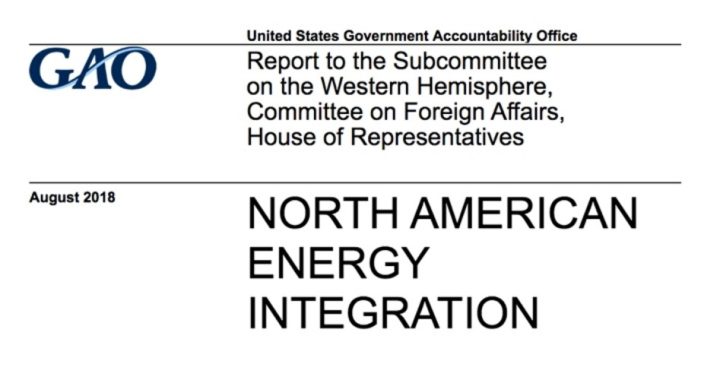
A startling new government report reveals an unprecedented level of collaboration on the integration of the energy sectors of all three North American countries, paving the way for a North American Union energy infrastructure.
The 59-page report published by the U.S. Government Accountability Office (GAO) for the House of Representatives’ Subcommittee on the Western Hemisphere documents in detail the progress of eight government agencies and departments in integrating the energy sectors of Canada, Mexico, and the United States.
The report, entitled “NORTH AMERICAN ENERGY INTEGRATION: Information about Cooperation with Canada and Mexico and among U.S. Agencies,” was discreetly posted on the GAO website in August 2018, likely with the hopes that it would go unnoticed.
According to the GAO study, “increased U.S. energy trade with Canada and Mexico — two of the United States’ top energy partners — is viewed as a major contribution to U.S. economic prosperity and energy security.” In other words, American sovereignty must be sacrificed in order to help the country be prosperous and have secure energy sources.
“The United States cooperates with Canada and Mexico on integrating North American energy markets and infrastructure (energy integration),” the study found. Further elaborating, “Cooperation occurs at the presidential and ministerial levels (e.g., the countries’ secretaries or ministries of energy) for strategic issues and at the agency level for technical issues.”
Energy is one of the topics discussed by the leaders of all three countries at trilateral and bilateral meetings. “The U.S. Secretaries of Energy and State also hold trilateral and bilateral meetings with their Canadian and Mexican counterparts,” according to the report.
As for the activity of government agencies participating in this integration, the report states:
Eight U.S. agencies have engaged in multiple efforts to facilitate North American energy integration. DOE [Department of Energy] generally as the lead agency on energy integration issues, while the Department of State — the lead agency on foreign policy — also leads some bilateral and trilateral efforts.
The eight U.S. agencies identified in the G.A.O. report as being complicit in energy integration schemes are the:
• Department of Energy,
• Department of Interior,
• Department of Commerce,
• Department of State,
• Department of Transportation,
• Federal Energy Regulatory Commission,
• United States Agency for International Development (USAID), and
• Department of Treasury
Of the various government officials from these agencies that the GAO surveyed and interviewed, a total of 81 energy integration-related schemes were identified as having been conducted from 2014 through 2017. Those energy integration schemes are listed and summarized in Appendix III, pages 42 to 52 of the report.
U.S., Canadian, and Mexican officials “expressed general satisfaction with intergovernmental cooperation on energy integration” and also suggested “further work in areas such as aligning energy regulations,” according to the report. (Emphasis added.)
In other words, the next step in the destruction of the sovereignty of all three countries is to make the energy regulations of all three countries the same in order to more easily facilitate their merger.
The logical conclusion of these 81 energy integration schemes that further push to align the energy regulations of all three sovereign nations is a North American Union, much like the present, already integrated, European Union.
The North American Free Trade Agreement (NAFTA) is regarded as the foremost step toward regional government and eventual world government. As former Secretary of State and key Deep State apparatchik Henry Kissinger observed during the initial consideration of NAFTA back in 1993:
The revolution sweeping the Western Hemisphere can point the way to an international order based on cooperation. It is this revolution that is at stake in the ratification of NAFTA. What Congress will soon have before it is not a conventional trade agreement but the hopeful architecture of a new international system. [Emphasis added.]
According to page six of the GAO report, “NAFTA has enhanced North American energy integration, facilitating a greater flow of oil, natural gas, and petroleum-derived products among all three North American countries.”
As for the new NAFTA negotiations, the report stated that it would have little effect on North American energy integration. “State and DOE officials we interviewed said they did not expect the U.S. renegotiation of NAFTA and withdrawal from the Paris Agreement to have a significant impact and stated that the energy sector in North America is already well integrated,” the report stated. (Emphasis added.)
Among the energy integration schemes identified in Appendix III of the report are some related to nuclear energy research, development, and security. For example, DOE is exploring “areas of mutual interest for [U.S.-Canadian-Mexican] trilateral cooperation, such as reactor technologies, spent fuel and waste disposal, and nuclear liability.”
The DOE is also involved in bilateral nuclear security cooperation with Mexico’s National Institute for Nuclear Research and the Laguna Verde Nuclear Power Plant. Among the areas of bilateral cooperation the DOE is working is cybersecurity for nuclear facilities.
On page 43, the report discusses efforts to integrate the U.S. and Mexican power grids. “DOE is partnering with Mexico’s Secretariat of Energy to develop a regional energy deployment system model with Mexico,” the report states. “The model will analyze different scenarios for the development of the U.S.-Mexico energy grid and the transmission infrastructure and assess opportunities for renewable energy integration and new ways to enhance the resiliency of the North American energy grid.”
The report also identifies the annual North American Leaders’ Summit as the “overarching mechanism supporting North American cooperation.” These meetings, the report states, are “supported by regular ministerial-level meetings between the Departments of State, Commerce, Defense, Energy, Justice, and the Interior; the Environmental Protection Agency; and their Canadian and Mexican counterparts.”
The last North American Leaders’ Summit was held on June 29, 2016, in Ottawa, Canada, between Canadian Prime Minister Justin Trudeau, Mexican President Enrique Peña Nieto, and then-U.S. President Barack Obama.
Although no future meetings have been scheduled yet with President Donald Trump, this report reveals the continued behind-the-scenes moves toward a North American Union by the Deep State.
It should be noted that “integration” by its very nature means the combination, unification, or merger of those things being integrated. The Oxford English Dictionary defines “integration,” as it relates to economic and political integration as, “The action or process of integrating.” Oxford then offers the following synonyms: “combination, amalgamation, incorporation, unification, consolidation, merger, fusing, blending, meshing, homogenization, homogenizing, coalescing, assimilation, concatenation.”
Instead of three separate energy sectors or infrastructure systems, the United States will share and be part of the larger amalgamated North American energy section. Rather than referring to the U.S., Canadian, and Mexican energy grids as three separate autonomous energy grids under the sovereign jurisdiction of each country, the report refers to “the North American energy grid,” and how the U.S. and Mexico are working on bilateral efforts to strengthen its resilience.
By further aligning energy regulations of all three countries, U.S. citizens, local municipalities, and both state and regional U.S. energy companies would be subject not to any local, state, or even national energy regulations, but rather new international regulations for all of North America. What affect would this have on the average American household’s energy consumption?
This international harmonization attemps to erase the boundaries between the three countries and set up new international standards, rules, and regulations. Local and state governments would be helpless to change them, and Congress would have little to no say. Instead the Executive branch — the president, secretary of energy, and other departmental and agency heads — will not seek what is in the best interest of Americans but rather what is in the best interest of North America, not wanting to disturb “North American free trade” and “trilateral cooperation.”
In fact, this has been the situation with U.S. trade policy since the passage of the Trade Agreements Acts of 1934, in which the 73rd Congress abdicated its constitutional trade power to the Executive branch, which in turn further abdicated it to international authorities and schemes such as the General Agreement on Tariffs and Trade (GATT), followed by the creation and U.S. entry into the World Trade Organization (WTO), in the name of “freeing world trade.”
Now the same is being done with American energy policy, in the name of “energy security” and “trilateral cooperation.” The end result will be a United States that does not control its own energy policy and power plants, but is a mere cog in the greater North American energy system, which in turn may seek further harmonization or integration with the rising energy grids of a united Central and South America, the European Union, and possibly also the Eurasian Economic Union via Alaska and Russia.
While that all may remain far off in the future, for now the Deep State is well on its way toward integrating and cementing the energy grid for a united North America.
If anything, this report highlights how, despite the election of Trump, the Deep State remains well-entrenched within the U.S. government. The scope and depth of the various energy integration schemes mentioned in this report demonstrate just how vital NAFTA is to the Deep State and their globalist desires for regional and world government.
As ominous as its findings are, this GAO report can also serve as an effective tool to educate others of how dangerously close the United States is to losing its national sovereignty and freedoms, especially in the area of energy. And it further underscores the need to Get US Out! of NAFTA.
Image: screenshot from cover page of GAO report





